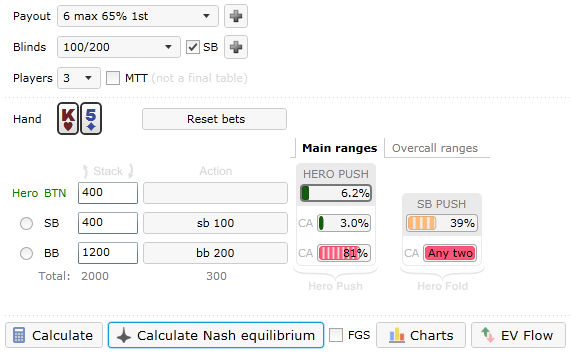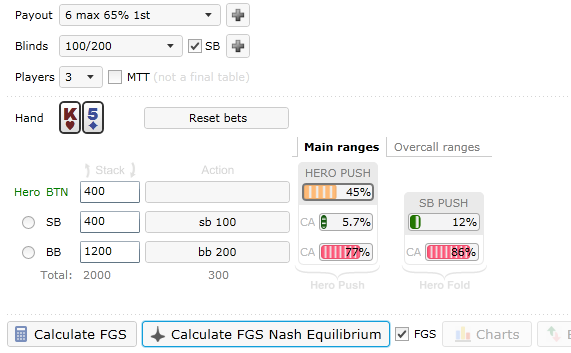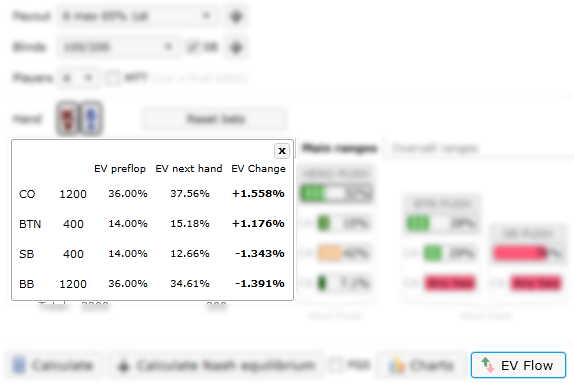Wow - it has finally happened! The FGS update was highly anticipated, and I am very glad to announce that it is now live and available for all ICMIZER
subscribers.
So what is FGS, and why is it important?
FGS stands for Future Game Simulations. FGS addresses some of the traditional problems of the ICM model. FGS is not an entirely new concept - it is based on
the usual Malmuth-Harville ICM, but more on that later. Since we are dealing with ICM problems, HUSNG players should realize that they always deal with
pot odds and FGS doesn't affect HU preflop decisions at all.
Typical ICM has the following weakness: we look at players and positions, and we perform a calculation and when we calculate EV of stacks we really only take
into account the following two variables:
-
Stacks
-
Payout
However, in reality there is a critical dynamic at play - blinds are moving each turn, and when we look at the two variables above, we can
see that player position is ignored. So if UTG has 300 chips and we calculate his/her ICM equity, and we then swap him with the SB and calculate his
stack's ICM value, we will arrive at the same value.
This is a problem.
When we have a short stack in UTG, we are facing an upcoming big blind. This always has some hidden cost which typical ICM calculations cannot
quantify. So usually in this kind of spot, we take pushes with a negative EV edge from an ICM perspective. The question of how low we can go is always
difficult; there is always some guess work involved, and different situations call for different negative edges. Note that since ICM only cares about a single hand, we are
trying to manually take the future into account by making those negative pushes from early positions while short-stacked.
This is where FGS comes to the rescue! With FGS, we actually look ahead into the future - we take position and big blind dynamics into account and get different
results than with typical ICM. So UTG's pushing range would become much wider, compared to standard ICM-based calculations, and therefore we won't have to take a negative
edge.
With FGS, we are simply getting a wider +EV range in the same spot. So if someone would be following typical ICM advice and you were following FGS
advice, you culd expect much better results in the late phase where players are short-stacked.
An example FGS calculation and comparison to a typical ICM calculation
Visual examples usually work better than a wall of text - let's examine the following scenario:
Nash equilibrium pushing ranges according to standard ICM

Here we are under the gun with 2 blinds remaining, and we have performed a standard ICM-based Nash equilibrium calculation.
We can see the problems with ICM: UTG's range is extremely tight because it assumes that SB will be pushing wide. Of course if that was the case, we would be more
likely to fold and dream about cashing if BB busts SB.
However everybody realizes that in the next hand, we will be on the BB, and and the BB will reach the SB after us. Therefore, the SB is not really likely to push as wide here as
the "single-hand-aware" ICM calculation suggests. We would be trying to make a negative shove, since with 2 blinds it makes sense that we must be pushing at
least 30% of hands here and probably more (again, we need to think about common sense and next hand).
Now let's look at FGS-based ranges:
Nash equilibrium pushing ranges according to FGS

We can see that FGS took into account what we know from our game experience! SB isn't pushing 39% as they did before. If we fold, the SB would be only playing
12% of hands, limiting himself to premium hands and waiting for us to bust.
Our range has also changed - we are now up from 6% to 45%, and we are basically pushing half of the hands we are dealt.
In these situations, it should be pretty obvious that players who adopt FGS-based ranges in the SB and UTG positions would be making much better decisions and winning
more money than players who follow traditional ICM-based advice.
The curious thing about this example is that the UTG push range literally swapped with the SB push range after future game dynamics were taken into account
What else is new in this update?
This update was mostly about FGS, but I have also added a few features to the user interface which the FGS algorithm is using behind the scenes.
-
Performance:
Looking ahead into the future, calculating Nash equilibrium ranges, and performing ICM calculations all result in very expensive computational operations. In order to maintain high quality service, I have added new servers so ICMIZER is now performing calculations on the cloud. I will be closely monitoring performance and will
ensure that response times are fast and that the tool is as reliable as it has always been. I also needed to optimize a lot of existing algorithms in order to improve the performance of
calculations.
SNG Wizard is promising to finally display a result grid with EV for each hand, something we have had from the start. But as you have read, ICMIZER just got more powerful than ever.
I don't think there is a chance that Wizard can catch up now. If someone still had doubts about making the switch, it's definitely the right time now. This update
took a huge amount of work, and I am confident that FGS-based strategy will help take your poker game to the next level.
-
EV Flow table:
Behind the scenes, FGS determines how many players are going to be dealt into the upcoming hand, and based on that calculates their
equity after the hand.

For this calculation, we need stacks, bets, blinds, payout, and ranges for all players. You can use the EV Flow command in order to see how equity moves around the table.
You will usually observe that it moves from BB and SB positions towards BTN, or from medium stacks to big stacks.
All in all, I believe this will be a valuable asset in the analysis of a number of critical spots.
-
Nash calculation is now possible for spots where one player is auto-all in.
This was also a prerequisite for FGS calculations. In the upcoming hand, short-stacked players may end up all-in on the big blind or small blind or even
blind out by posting an ante. Calculation of both EV Flow and Nash equilibrium ranges is required for these kind of spots. It is now available from the ICMIZER
user interface too.
When and where FGS is most important
Usually FGS will play a key role when the table is relatively short-stacked (6 or less players) and stacks are shorter than 10 big blinds, with some real short stacks of approximately 5 blinds. For larger numbers of player or deeper stacks, FGS-based results will not be very different from usual ICM based results.
It becomes especially important on the bubble of hyper or super-turbo STT tournaments or satellites.
The positions which are usually affected the most are UTG, SB and BB.
In MTTs or MTT SNGs, FGS probably only makes sense on the final table under the conditions described above.
Conclusion
This is a big update, and I know that it was highly anticipated by professional single table SNG (STT) players. I hope you guys will enjoy the new
functionality! If you aren't yet an ICMIZER user, feel free to give FGS a test-drive using the demo tool on this website.
This is the first step in FGS functionality in ICMIZER. More is coming, and I will be adding more flexibility to FGS settings.
I will also record a video and prepare a more detailed article describing FGS and other changes included in this update.
Q, developer of ICMIZER
PS: Oh, and I hope you guys are ready for the upcoming Quiz release. Something is telling me that it will be huge. It will still take some time though.